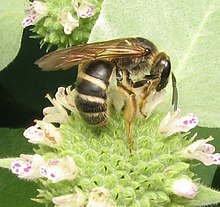Lasioglossum
| Lasioglossum | |
|---|---|

| |
| Scientific classification | |
| Kingdom: | Animalia |
| Phylum: | Arthropoda |
| Class: | Insecta |
| Order: | Hymenoptera |
| Family: | Halictidae |
| Tribe: | Halictini |
| Genus: | Lasioglossum Curtis, 1833 |
| Subgenera | |
|
see text | |

The sweat bee genus Lasioglossum is the largest of all bee genera, containing over 1700 species in numerous subgenera worldwide.[1][2] They are highly variable in size, coloration, and sculpture; among the more unusual variants, some are cleptoparasites, some are nocturnal, and some are oligolectic. Most Lasioglossum species nest in the ground, but some nest in rotten logs.[citation needed]
Social behavior among species of Lasioglossum is extraordinarily variable; species are known to exhibit solitary nesting, primitive eusociality, and social parasitism. Colony sizes vary widely, from small colonies of a single queen four or fewer workers to large colonies of >400 workers and perennial life cycles.[3]
The genus Lasioglossum can be divided into two informal series based on the strength of the distal veins of the forewing.[4] The Lasioglossum series (or strong-veined Lasioglossum) is mostly composed of solitary or communal species, even if some species like L. aegyptiellum show signs of division of labour indicative of eusociality.[1]

The Hemihalictus series (or weak-veined Lasioglossum) includes species with a wide range of sociality.[5][3] The Hemihalictus series is composed of species which are solitary, communal, primitively eusocial, cleptoparasitic, or socially parasitic.[citation needed] Eusocial species may have small colonies with only one or a few workers or large colonies with dozens of workers. Large colony sizes occur in L. marginatum, which forms perennial colonies lasting five or six years, with hundreds of workers; this species is the only halictine bee with perennial colonies.[3]
Subgenera[]
A list of subgenera (modified from Michener's Bees of the World):
Lasioglossum series: , , , , , , Lasioglossum s. str., , , , , , .
Hemihalictus series: , , Dialictus, , , , , , .
Subgeneric classification of Lasioglossum remains controversial, with disagreement among experts on the number and extent of subgenera.
Two of the better-known species are the European Lasioglossum malachurum and the North American species Lasioglossum zephyrus.
See also[]
References[]
- ^ Jump up to: a b Gibbs, J., et al. (2012). Phylogeny of halictine bees supports a shared origin of eusociality for Halictus and Lasioglossum (Apoidea: Anthophila: Halictidae). Molecular Phylogenetics and Evolution 65(3), 926-39.
- ^ Ascher, J. S. and J. Pickering. 2011. Discover Life bee species guide and world checklist (Hymenoptera: Apoidea: Anthophila).
- ^ Jump up to: a b c Danforth, Bryan N.; Conway, Lindsay; Ji, Shuqing (2003-02-01). "Phylogeny of eusocial Lasioglossum' reveals multiple losses of eusociality within a primitively eusocial clade of bees (Hymenoptera: Halictidae)". Systematic Biology. 52 (1): 23–36. doi:10.1080/10635150390132687. ISSN 1063-5157.
- ^ Michener, C.D. (2000). The Bees of the World. Johns Hopkins University Press. 913 pp.
- ^ Michener, C.D. (1974). The Social Behavior of the Bees. Harvard University Press. 404 pp.
External links[]
- Lasioglossum
- Bee genera
- Taxa named by John Curtis